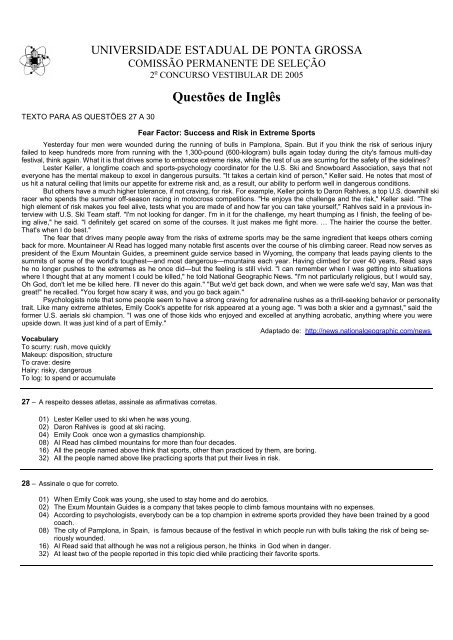Todas as provas - Universidade Estadual de Ponta Grossa
Todas as provas - Universidade Estadual de Ponta Grossa
Todas as provas - Universidade Estadual de Ponta Grossa
Create successful ePaper yourself
Turn your PDF publications into a flip-book with our unique Google optimized e-Paper software.
TEXTO PARA AS QUESTÕES 27 A 30<br />
UNIVERSIDADE ESTADUAL DE PONTA GROSSA<br />
COMISSÃO PERMANENTE DE SELEÇÃO<br />
2 o CONCURSO VESTIBULAR DE 2005<br />
Questões <strong>de</strong> Inglês<br />
Fear Factor: Success and Risk in Extreme Sports<br />
Yesterday four men were woun<strong>de</strong>d during the running of bulls in Pamplona, Spain. But if you think the risk of serious injury<br />
failed to keep hundreds more from running with the 1,300-pound (600-kilogram) bulls again today during the city's famous multi-day<br />
festival, think again. What it is that drives some to embrace extreme risks, while the rest of us are scurring for the safety of the si<strong>de</strong>lines?<br />
Lester Keller, a longtime coach and sports-psychology coordinator for the U.S. Ski and Snowboard Association, says that not<br />
everyone h<strong>as</strong> the mental makeup to excel in dangerous pursuits. "It takes a certain kind of person," Keller said. He notes that most of<br />
us hit a natural ceiling that limits our appetite for extreme risk and, <strong>as</strong> a result, our ability to perform well in dangerous conditions.<br />
But others have a much higher tolerance, if not craving, for risk. For example, Keller points to Daron Rahlves, a top U.S. downhill ski<br />
racer who spends the summer off-se<strong>as</strong>on racing in motocross competitions. "He enjoys the challenge and the risk," Keller said. "The<br />
high element of risk makes you feel alive, tests what you are ma<strong>de</strong> of and how far you can take yourself," Rahlves said in a previous interview<br />
with U.S. Ski Team staff. "I'm not looking for danger. I'm in it for the challenge, my heart thumping <strong>as</strong> I finish, the feeling of being<br />
alive," he said. "I <strong>de</strong>finitely get scared on some of the courses. It just makes me fight more. … The hairier the course the better.<br />
That's when I do best."<br />
The fear that drives many people away from the risks of extreme sports may be the same ingredient that keeps others coming<br />
back for more. Mountaineer Al Read h<strong>as</strong> logged many notable first <strong>as</strong>cents over the course of his climbing career. Read now serves <strong>as</strong><br />
presi<strong>de</strong>nt of the Exum Mountain Gui<strong>de</strong>s, a preeminent gui<strong>de</strong> service b<strong>as</strong>ed in Wyoming, the company that leads paying clients to the<br />
summits of some of the world's toughest—and most dangerous—mountains each year. Having climbed for over 40 years, Read says<br />
he no longer pushes to the extremes <strong>as</strong> he once did—but the feeling is still vivid. "I can remember when I w<strong>as</strong> getting into situations<br />
where I thought that at any moment I could be killed," he told National Geographic News. "I'm not particularly religious, but I would say,<br />
Oh God, don't let me be killed here. I'll never do this again." "But we'd get back down, and when we were safe we'd say, Man w<strong>as</strong> that<br />
great!" he recalled. "You forget how scary it w<strong>as</strong>, and you go back again."<br />
Psychologists note that some people seem to have a strong craving for adrenaline rushes <strong>as</strong> a thrill-seeking behavior or personality<br />
trait. Like many extreme athletes, Emily Cook's appetite for risk appeared at a young age. "I w<strong>as</strong> both a skier and a gymn<strong>as</strong>t," said the<br />
former U.S. aerials ski champion. "I w<strong>as</strong> one of those kids who enjoyed and excelled at anything acrobatic, anything where you were<br />
upsi<strong>de</strong> down. It w<strong>as</strong> just kind of a part of Emily."<br />
Adaptado <strong>de</strong>: http://news.nationalgeographic.com/news<br />
Vocabulary<br />
To scurry: rush, move quickly<br />
Makeup: disposition, structure<br />
To crave: <strong>de</strong>sire<br />
Hairy: risky, dangerous<br />
To log: to spend or accumulate<br />
27 – A respeito <strong>de</strong>sses atlet<strong>as</strong>, <strong>as</strong>sinale <strong>as</strong> afirmativ<strong>as</strong> corret<strong>as</strong>.<br />
01) Lester Keller used to ski when he w<strong>as</strong> young.<br />
02) Daron Rahlves is good at ski racing.<br />
04) Emily Cook once won a gym<strong>as</strong>tics championship.<br />
08) Al Read h<strong>as</strong> climbed mountains for more than four <strong>de</strong>ca<strong>de</strong>s.<br />
16) All the people named above think that sports, other than practiced by them, are boring.<br />
32) All the people named above like practicing sports that put their lives in risk.<br />
28 – Assinale o que for correto.<br />
01) When Emily Cook w<strong>as</strong> young, she used to stay home and do aerobics.<br />
02) The Exum Mountain Gui<strong>de</strong>s is a company that takes people to climb famous mountains with no expenses.<br />
04) According to psychologists, everybody can be a top champion in extreme sports provi<strong>de</strong>d they have been trained by a good<br />
coach.<br />
08) The city of Pamplona, in Spain, is famous because of the festival in which people run with bulls taking the risk of being seriously<br />
woun<strong>de</strong>d.<br />
16) Al Read said that although he w<strong>as</strong> not a religious person, he thinks in God when in danger.<br />
32) At le<strong>as</strong>t two of the people reported in this topic died while practicing their favorite sports.
















